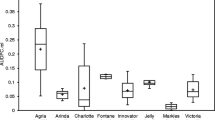Abstract
The effect of northern leaf blight (NLB) or leaf defoliation on the yield of nine sweet corn cultivars was studied in field experiments. Plants were defoliated or infected in the bottom, middle or top third of the leaf canopy. The effect of defoliation or infection on yield was significantly higher for plants treated 55 days after planting than for those treated 70 days after planting. Cultivar response differed significantly for both treatments, the most sensitive cultivar being ‘Jubilee’ and the least sensitive being Ssupersweet 7900. In all cases, the highest yield loss was recorded when the middle third of the leaf canopy was treated. The relative importance of the top third of the leaf canopy increased if the treatment was done 3 weeks before harvesting. This study emphasized the importance of leaf position, cultivar, and plant growth stage for evaluating losses caused by NLB, and may explain the failure of various models to describe yield loss due to NLB.
Similar content being viewed by others
References
Hooker, A.L. (1979) Estimating disease losses based on the amount of healthy leaf tissue during the plant reproductive period.Genetika 2:181–192.
Hooker, A.L. and Perkins, J.M. (1980) Helminthosporium leaf blights of corn — the state of the art.Proc. 35th Annu. Corn and Sorghum Res. Conf. (Chicago, IL), pp. 68–87.
James, W.C. (1974) Assessment of plant disease and losses.Annu. Rev. Phytopathol. 12:27–48.
Levy, Y. (1985) The effect of defoliation treatments on yield in sweet corn.Abstr. American Phytopathology Soc. Annu. Meeting (Reno, NV), No. 738.
Levy, Y. (1991) Variation in fitness among field isolates ofExserohilum turcicum in Israel.Plant Dis. 75:163–166.
Levy, Y. and Leonard, K.J. (1988) Yield loss in sweet corn in response to defoliation or infection byExserohilum turcicum.J. Phytopathol. 128:161–171.
Perkins, J.M. and Pedersen, W.L. (1987) Disease development and yield loss associated with northern leaf blight on corn.Plant Dis. 71:940–943.
Raymundo, A.D. and Hooker, A.L. (1981) Measuring the relationship between northern corn leaf blight and yield loss.Plant Dis. 65:325–337.
Shapiro, C.A., Peterson, T.A. and Flowerday, A.L. (1986) Yield loss due to simulated hail damage on corn. A comparison of actual and predicted values.Agron. J. 78:585–589.
Tuite, J. (1969) Plant Pathological Methods. Burgess Publ. Co., Minneapolis, MN.
Ullstrup, A.J. and Miles, S.R. (1957) The effect of some leaf blights of corn on grain yield.Phytopathology 47:331–336.
Vasilas, B.L. and Seif, R.D. (1985) Defoliation effect of two corn inbreds and their single cross hybrid.Agron. J. 77:816–820.
Waggoner, P.E. and Berger, R.D. (1987) Defoliation disease and growth.Phytopathology 77:393–398.
Author information
Authors and Affiliations
Rights and permissions
About this article
Cite this article
Solomonovttz, S., Levy, Y. & Pataky, J.K. Yield loss of sweet corn cultivars in response to defoliation and to infection byexserohilum turcicum . Phytoparasitica 20, 113–121 (1992). https://doi.org/10.1007/BF02981277
Received:
Revised:
Issue Date:
DOI: https://doi.org/10.1007/BF02981277




